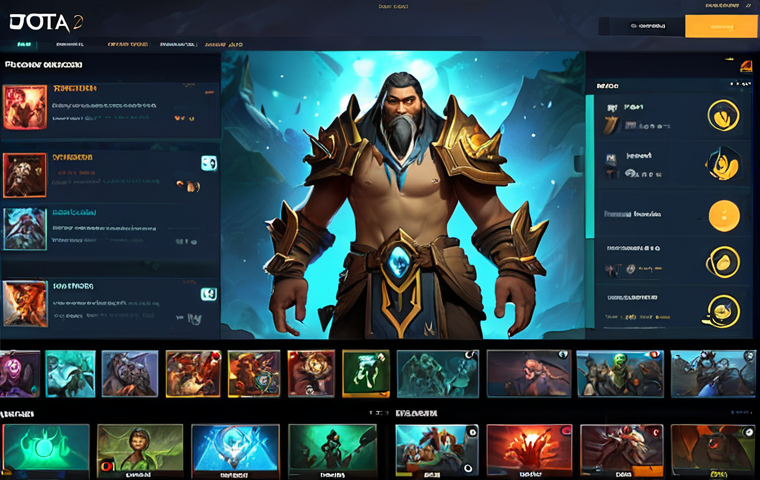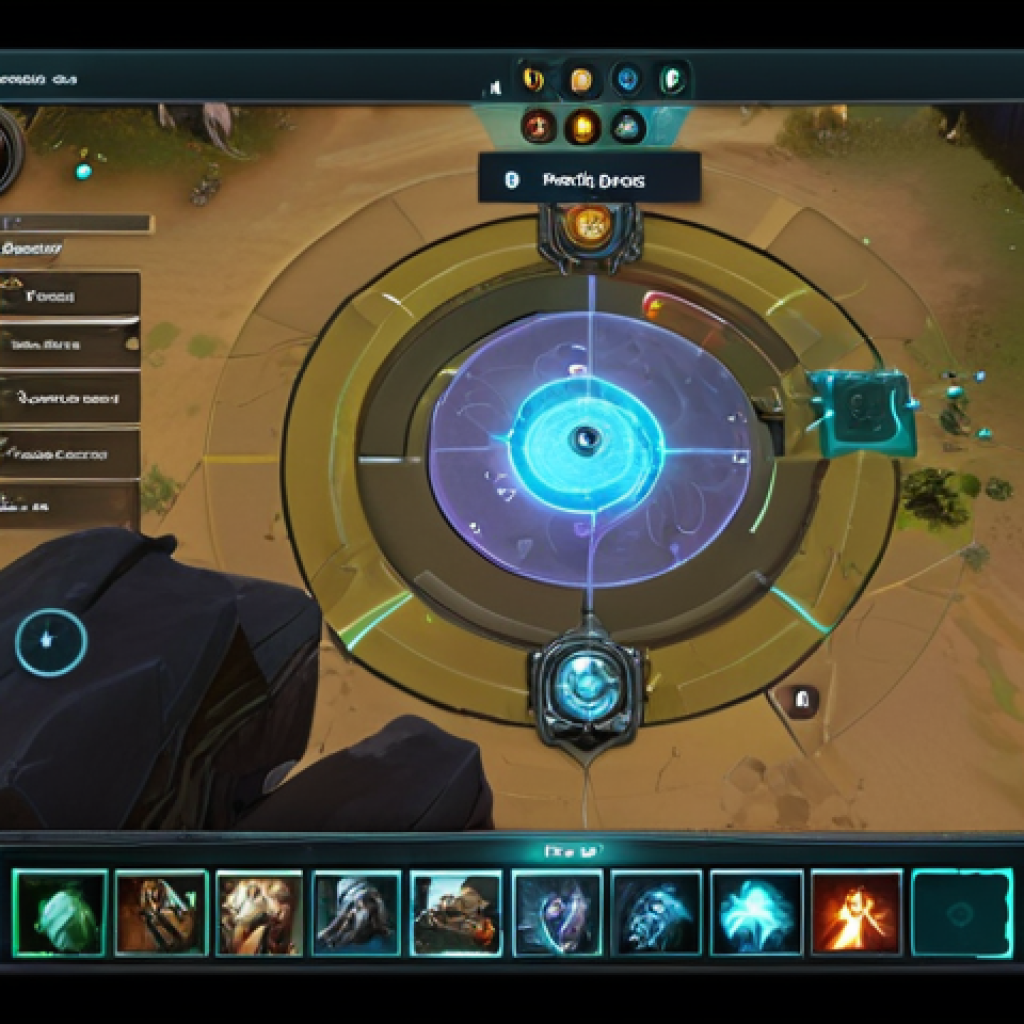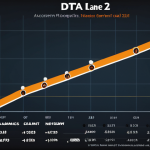Remember that distinct feeling when you logged into Dota 2 after a major patch and everything looked… totally different? That initial jolt, maybe a mix of genuine excitement and mild disorientation, is exactly what I’ve personally experienced with the latest interface overhaul.
It’s a moment that always sparks a blend of curiosity and the inevitable need for adaptation. Valve’s unwavering commitment to refining the player experience is evident with each passing update, yet these shifts are rarely just cosmetic; they invariably spark heated debates and force us to relearn the deep muscle memory we’ve meticulously built over thousands of hours.
From my perspective, these changes reflect a broader, more strategic trend in competitive gaming UI/UX – a relentless push towards cleaner layouts and more intuitive information delivery.
This is absolutely crucial for both new player onboarding, making the game less intimidating, and for the lightning-fast, pixel-perfect decisions demanded in high-tier pro play.
We’re witnessing a clear move to minimize visual clutter, aiming to enhance engagement and accessibility, potentially even aligning with future immersive trends like AR/VR integration or a much more streamlined, dynamic spectator experience.
This continuous evolution isn’t just about making the game prettier; it’s vital for Dota 2’s longevity in the fiercely competitive esports landscape, ensuring it remains appealing and sustainable for years to come.
Ultimately, every single pixel matters for player retention and the pure joy of the game. Let’s dive into the details below.
Navigating the Evolving Landscape of In-Game Information

Stepping into Dota 2 after a significant UI patch always feels like walking into a familiar room that’s been subtly, yet fundamentally, rearranged. My initial reaction is invariably a mix of “Oh, this is cool!” and “Wait, where did they put that again?” I remember a specific instance logging in, eager to jump into a ranked game, and finding my hero selection screen completely reimagined. It wasn’t just a minor tweak; the entire flow felt different, from the ban phase to the pick order. This isn’t just about aesthetics; it’s about muscle memory, and for a game as fast-paced as Dota 2, those few seconds of disorientation can feel like an eternity. Over the years, I’ve learned to embrace these changes, seeing them as part of the game’s living, breathing nature. It forces me to actively re-engage with the interface, to truly understand the new logic behind its design choices, rather than relying on autopilot. This is crucial because, in the heat of battle, every millisecond counts, and fumbling for an item or checking a stat can be the difference between victory and defeat. From my own personal experience, adapting quickly to these shifts has often given me an edge in the early stages of a new patch, as many players are still struggling with the learning curve.
1. The Subtleties of Visual Cues and Information Density
One of the most impactful changes, from my perspective, has been the refinement of visual cues and the way information is presented. Valve has seemingly focused on reducing clutter while simultaneously making critical data more accessible. For instance, the redesign of the top-bar interface, where gold, KDA, and net worth are displayed, initially felt strange because I was so used to the old layout. However, after a few games, I realized how much cleaner it felt, allowing my eyes to more quickly snap to the information I needed without getting lost in a sea of numbers and icons. It’s a delicate balance; too much information can overwhelm, especially for new players, but too little leaves experienced players wanting more granular data. My personal workflow has adapted by consciously taking a moment during downtime (like when walking to lane or after a death) to scan the new layouts, reinforcing the new visual pathways in my brain. It’s almost like learning a new language, where you’re constantly translating until the new vocabulary becomes second nature. This iterative design philosophy truly underpins the longevity and competitive integrity of Dota 2, ensuring that it remains at the forefront of the esports scene by consistently delivering a refined user experience.
2. Redefining Accessibility for a Global Audience
Beyond competitive advantages, these UI updates often have a profound impact on the game’s accessibility, especially for new players. I’ve personally tried to introduce friends to Dota 2, and the sheer complexity of the old UI was often a major barrier. The simplified layouts, clearer iconography, and more intuitive tutorials integrated into the new interface make it significantly less intimidating. While some veteran players might lament the loss of certain niche functionalities or the “raw” feel of older versions, I believe these changes are vital for the game’s growth and survival. Think about it: every new player who sticks around contributes to the community, the player base, and ultimately, the financial health of the game through battle passes and cosmetics. It’s not just about making the game easier; it’s about making it understandable and enjoyable from the moment you boot it up, reducing the initial friction that often pushes potential players away. This focus on onboarding is critical, as it broadens the appeal of Dota 2 beyond its hardcore base, attracting a more diverse group of players who might have previously found its interface impenetrable.
Strategic Re-Calibrations: How UI Impacts Gameplay Decisions
The interface in Dota 2 is far more than just a pretty face; it’s a direct conduit to strategic decision-making. Every icon, every numerical display, every piece of information presented to you influences how you play the game. When Valve tinkers with this conduit, it forces a re-evaluation of ingrained strategies. I’ve personally felt the impact of this during intense teamfights. For example, changes to the Roshan timer or Aegis status display, even if subtle, require immediate adaptation. My eyes used to flick to a specific corner of the screen, now they need to go elsewhere, and in a game where milliseconds count, that shift can cost you. It’s not just about finding information; it’s about the speed and efficiency with which you can process it and turn it into action. This constant dance between learning and adapting is what keeps the game fresh and demanding, even after thousands of hours. It challenges your cognitive load, pushing you to refine your mental models of the game with each significant update. This high-stakes environment is precisely why the UI must be both robust and adaptable, constantly balancing clarity with the depth required for competitive play.
1. The Shop Experience: A Merchant’s New Menu
The biggest, most impactful change that immediately comes to mind for me is always the shop interface. I remember the panic the first time the shop was overhauled years ago – suddenly, my meticulously crafted quick-buy binds felt obsolete, and finding specific components felt like an archaeology expedition. The recent iterations, thankfully, have focused on clarity and speed, aiming to streamline item acquisition during critical moments. From my perspective, the new categorization, the search functionality, and even the recommended items section have become far more intuitive. It’s no longer about memorizing every single item recipe by heart; the UI now guides you more efficiently, which is a blessing for newer players and a time-saver for veterans. My personal routine has evolved to trust the new “suggested items” more, especially early game, rather than relying solely on my outdated mental cheat sheet. This allows me to focus more on lane dynamics and less on tabulating exact gold values for my next component. The ability to quickly see what items your teammates are building, or what components they’re missing, has also been a game-changer for team coordination, reducing the need for constant voice communication about item timings.
2. Navigating the Map: A Commander’s Overhead View
The minimap and overall map interface are arguably the most crucial UI elements for strategic play. I’ve observed significant improvements in how information is conveyed here, especially regarding ward placements, tower statuses, and even hero movements. The clarity of hero icons, the distinct representation of neutral camps, and the subtle visual cues for things like “missing” pings or Roshan status have all contributed to a more informed playing experience. Personally, I rely heavily on the minimap for situational awareness, and any improvement here directly translates to better decision-making in split-seconds. I recall a specific game where the updated minimap clarity allowed me to spot an enemy hero rotating much earlier than I would have before, leading to a crucial de-ward and gank counter. These seemingly small adjustments cumulatively create a massive difference in how quickly players can assess threats and opportunities across the entire map, which is fundamental to high-level competitive play. It’s about empowering players to be better commanders on the battlefield, providing all the necessary intel at a glance.
The Human Element: Emotions, Frustrations, and Triumphs
Dota 2 isn’t just about cold, hard data; it’s a deeply emotional experience. From the euphoria of a perfectly executed combo to the crushing despair of a lost teamfight, our feelings are intrinsically linked to our performance. And the UI, believe it or not, plays a huge role in this. I’ve felt genuine frustration when a new UI element momentarily obscured critical information, leading to a misclick or a missed spell. But I’ve also felt a surge of satisfaction when a particularly well-designed new feature clicks into place, making a complex interaction suddenly seamless. It’s this emotional rollercoaster, exacerbated by UI changes, that makes the adaptation process so intensely personal for every player. We’re not just re-learning button presses; we’re re-calibrating our entire emotional and cognitive relationship with the game. This psychological aspect is often overlooked, but from my perspective, it’s absolutely vital for player retention and enjoyment. A UI that understands and mitigates frustration, while amplifying moments of clarity and control, is a UI that keeps players coming back for more.
1. The Initial Learning Curve: A Necessary Evil?
Every major UI overhaul brings with it a learning curve, and I’ve certainly experienced my fair share of frustration during these periods. There’s that initial feeling of being less efficient, less powerful, simply because the tools you rely on have shifted. I remember vividly trying to adjust my quick-cast settings after a patch changed the options menu layout, spending frustrating minutes trying to find the exact toggle I needed. It’s a humbling experience, forcing you to slow down and meticulously explore areas of the interface you previously took for granted. However, I’ve also come to see this “necessary evil” as a growth opportunity. It forces me to re-examine my habits, to question whether my old workflows were truly optimal, or if I was just clinging to them out of habit. Often, I discover new, more efficient ways of doing things that I wouldn’t have considered without the forced disruption. It’s a testament to the fact that even long-time players aren’t immune to change, and continuous adaptation is part of the Dota 2 journey.
2. Celebrating Streamlined Workflows and Intuitive Design
On the flip side, the moments when a new UI element or workflow truly shines are incredibly rewarding. I’ve experienced a genuine sense of relief and satisfaction when an often-clunky interaction suddenly becomes smooth and intuitive. For instance, the improvements to hero selection, allowing for better filtering and quick access to favorite heroes, have made pre-game rituals much less stressful for me. Before, I’d sometimes scramble to find a specific hero, especially if I was trying a new strategy. Now, the process is seamless. Similarly, enhancements to the post-game summary screen, making stats and replays easier to access, have greatly improved my ability to review my performance and learn from my mistakes. These are the unsung heroes of UI design – the changes that quietly make your life easier, reducing friction and allowing you to focus on the pure joy of playing the game. It’s these moments of intuitive design that truly demonstrate Valve’s commitment to continuous improvement, proving that they are listening to player feedback and striving for a truly refined experience.
Unpacking the Details: A Comparative Look at Key UI Elements
To truly appreciate the scope of these interface changes, it helps to break down specific components and compare their evolution. It’s not just about making things look different; it’s about improving functionality, clarity, and overall player experience. I’ve spent countless hours in the client, and I’ve seen firsthand how these small adjustments accumulate into significant impacts on gameplay flow and strategic depth. Below, I’ve put together a small comparison of how different elements might be perceived by players, highlighting the common trade-offs and improvements that come with each major overhaul. This is based on my personal observations and the general sentiment I’ve gathered from the community.
| UI Element | Previous Iteration (General Perception) | Current Iteration (General Perception) | My Personal Takeaway |
|---|---|---|---|
| Shop Interface | Cluttered, required memorization, slower navigation. | Streamlined, intuitive search, better categorization. | Faster item acquisition, less mental strain during fights. |
| Top Bar (HUD) | Dense, less distinct hero icons, sometimes hard to track. | Cleaner, more prominent hero statuses, clearer gold/KDA. | Improved glance value for critical game state info. |
| Scoreboard | Functional but often required scrolling for full view. | More compact, better at-a-glance team comparisons. | Quicker post-fight assessment of net worth and stats. |
| Minimap | Sometimes lacked clarity on stacked camps or exact ward spots. | Enhanced visual fidelity, better objective markers. | Superior map awareness, more precise movement and warding. |
As you can see from the table, there’s a clear trend towards increased clarity and efficiency. While every change might not be universally loved, the overall trajectory is towards a more polished and responsive interface that truly empowers players to focus on the game itself, rather than struggling with the tools. This deep dive into specific elements truly highlights the meticulous design process behind Dota 2’s continuous evolution. It’s a process of refinement, addressing pain points, and always striving for that elusive perfect balance between information and accessibility. My personal experience confirms that these shifts, while sometimes jarring, consistently push the game forward, making it a more enjoyable and competitive environment for everyone involved.
Beyond the Game: UI’s Role in Esports and Community Engagement
The interface of Dota 2 extends far beyond what we see in-game during a match. It encompasses the entire client experience, from the main menu to the spectating tools and even the community features. These broader UI changes have a massive impact on the game’s esports ecosystem and its ability to foster a vibrant, engaged community. I’ve personally spent countless hours not just playing, but also watching professional games and interacting with the community features, and I’ve seen how critical a well-designed client is for keeping players invested. A clunky spectating interface or an unintuitive community hub can quickly deter fans, regardless of how good the core gameplay is. It’s about providing a holistic experience that keeps players connected and entertained even when they’re not actively in a match. This holistic view of the UI is what truly elevates Dota 2 from just a game to a global phenomenon, ensuring its competitive scene remains accessible and engaging for millions of viewers worldwide.
1. The Evolution of Spectator UI: A Viewer’s Paradise
From a spectator’s standpoint, the UI overhauls have been nothing short of revolutionary. I remember the early days of watching professional Dota, where the observer tools were functional but often lacked the polish and depth of information we see today. Now, features like live hero statistics, net worth graphs, sophisticated kill recaps, and even integrated talent commentary have transformed the viewing experience. These enhancements allow me, as a viewer, to dive deeper into the strategic nuances of a match without needing an extensive knowledge base or constantly asking questions. The ability to quickly toggle between different player perspectives, or to view item builds and spell cooldowns at a glance, makes following high-level play incredibly engaging. It’s no exaggeration to say that these UI improvements have directly contributed to the massive growth and popularity of Dota 2 esports, making it accessible and exciting even for casual viewers. I personally find myself spending more time in the client watching replays or live games than ever before, simply because the viewing experience has become so refined and informative.
2. Fostering Community: The Client as a Social Hub
The Dota 2 client has increasingly become a social hub, and the UI plays a crucial role in facilitating community interaction. Features like guild systems, enhanced chat functions, and the improved Battle Pass interface (which often includes mini-games and community challenges) are all designed with social engagement in mind. I’ve seen firsthand how a well-designed client encourages players to interact, form bonds, and ultimately stay committed to the game. For example, the intuitive system for finding and joining lobbies or custom games has made it easier for me to connect with friends and explore new game modes. Similarly, the ability to easily commend or report players, and to see the impact of those actions, contributes to a healthier game environment. These seemingly minor UI elements collectively create a more welcoming and interactive space, transforming the client from a mere game launcher into a vibrant meeting place for millions of players. It truly underscores how every pixel, every button, has a role in shaping the social fabric of the Dota 2 universe, making it a truly unique and enduring community experience.
Looking Ahead: The Philosophy Behind Valve’s UI Evolution
It’s fascinating to ponder the overarching philosophy behind Valve’s continuous UI evolution for Dota 2. It’s clear they’re not just making arbitrary changes; there’s a strategic vision at play, one that balances tradition with innovation, and competitive integrity with accessibility. From my vantage point, it feels like a relentless pursuit of perfection, understanding that the game’s interface is its primary touchpoint with millions of players. They seem to understand that a game as complex as Dota 2 needs an interface that is not only functional but also intuitive and, at times, even beautiful. This commitment to iterative design, to constantly gather feedback and refine, is what separates Dota 2 from many other titles that might release a static UI and then move on. It speaks volumes about their long-term commitment to the game and its community. My own experiences with their updates often feel like participating in a grand, ongoing experiment, where each patch brings new insights into optimal design principles, keeping me invested not just as a player, but as an observer of game development itself.
1. Balancing Veteran Preferences with New Player Onboarding
One of the trickiest balancing acts for any long-running game is satisfying its loyal veteran base while simultaneously making the game approachable for newcomers. I’ve seen Valve navigate this tightrope with varying degrees of success through UI changes. Sometimes, a change feels geared entirely towards new players, leading to minor frustrations for veterans who have grown accustomed to a particular workflow. Other times, highly specific features cater directly to the competitive scene, leaving casual players slightly bewildered. However, the most successful UI updates are those that manage to serve both demographics, often by offering customizable options or by making core information clearer without sacrificing depth. It’s a testament to good design when a change that benefits a new player (like a clearer shop layout) also inadvertently streamlines the experience for a veteran. This careful consideration of diverse player needs is paramount to the game’s sustained growth, ensuring that the existing player base feels respected while simultaneously attracting fresh talent to the Dota 2 ecosystem. It’s a challenging but ultimately rewarding pursuit that shapes the game’s future.
2. Foreshadowing Future Trends: What’s Next for Dota’s UI?
When I look at the current trajectory of Dota 2’s UI, I can’t help but wonder what comes next. The focus on clarity, modularity, and responsiveness seems to hint at even more dynamic and personalized interfaces in the future. Could we see more augmented reality elements integrated into spectator modes? Will the in-game HUD become even more adaptive, changing based on hero roles or specific in-game events? My personal speculation leans towards deeper integration of analytics and personalized data, allowing players to instantly visualize their performance trends or specific hero matchups directly within the client. The push for cleaner, more intuitive designs also suggests a potential for cross-platform play optimization, although that remains a distant dream for many in the community. Ultimately, Valve’s continuous commitment to refining the player experience through UI updates isn’t just about the present; it’s about future-proofing Dota 2, ensuring it remains at the cutting edge of competitive gaming design for years to come. It’s an exciting thought, considering how much the game has already evolved, and it definitely keeps me looking forward to every new major patch.
Wrapping Up
As we’ve journeyed through the intricate world of Dota 2’s UI evolution, it becomes undeniably clear that these changes are far more than mere visual tweaks.
They reshape our strategic decisions, challenge our muscle memory, and even stir our emotions as players. Valve’s continuous commitment to refining this critical interface is a testament to their long-term vision, ensuring Dota 2 remains a vibrant, competitive, and accessible experience for both seasoned veterans and eager newcomers alike.
It’s a living canvas, constantly adapting and improving, always pushing the boundaries of what a game’s interface can achieve, and keeping us all hooked for the next big update.
Useful Information to Keep in Mind
1. Always read the patch notes: Before diving into a ranked game after a major update, take a few minutes to skim the official patch notes. Developers often highlight significant UI changes, saving you precious in-game disorientation.
2. Utilize demo mode or bot games: For truly radical UI overhauls, spend some time exploring the new layout in a pressure-free environment like demo mode or a custom game with bots. This allows you to re-familiarize yourself with placements and functionalities without impacting your MMR.
3. Customize early and often: Most modern game UIs offer extensive customization options. Don’t be afraid to experiment with hotkeys, scaling, and information displays to create a setup that perfectly suits your personal workflow and playstyle.
4. Embrace the learning curve: View UI changes as an opportunity to break old habits and discover more efficient ways to interact with the game. That initial frustration often leads to a more optimized and intuitive experience in the long run.
5. Provide constructive feedback: Developers genuinely listen to community feedback. If you encounter a UI element that’s genuinely problematic or brilliantly designed, take the time to share your thoughts respectfully on official forums or social media. Your input helps shape the future of the game.
Key Takeaways
Dota 2’s UI evolution is a continuous process that profoundly impacts every aspect of the game, from individual gameplay efficiency and strategic decision-making to overall accessibility, community engagement, and esports growth.
Valve’s design philosophy strives to balance veteran preferences with new player onboarding, consistently refining the interface to enhance clarity, intuition, and performance.
Adapting to these changes is crucial for players, as it not only improves individual performance but also contributes to the game’s enduring success and competitive integrity.
Frequently Asked Questions (FAQ) 📖
Q: When a major patch drops, especially with a UI overhaul, what’s that initial feeling like for players?
A: Oh man, it’s like a sudden jolt, isn’t it? I remember logging in after one particular update – the one that really flipped the shop around – and just staring at the screen for a solid minute, a mix of genuine “whoa, this is new!” excitement and total disorientation.
It’s that immediate recognition that everything you’ve meticulously built into muscle memory over hundreds, even thousands, of hours is suddenly… different.
It always sparks this weird blend of curiosity and, frankly, a slight dread of having to re-adapt. But hey, that’s Dota, right? Constant evolution.
Q: These major UI changes often spark huge debates and force players to relearn things. Why does Valve commit to these seemingly disruptive overhauls?
A: That’s a question I’ve found myself asking pretty loudly in voice chat more than once after a particularly jarring update, trust me! But from my perspective, having played for years and watched the game evolve, these shifts are rarely just cosmetic.
Valve’s commitment seems to be about genuinely refining the player experience. They’re strategic. Think about it: they’re constantly pushing for cleaner layouts and more intuitive information delivery.
It’s not just about making the game prettier; it’s about making it more efficient to play, especially when every millisecond counts in a high-stakes match.
It’s a painful but necessary evolution, I guess.
Q: Beyond just “looking cleaner,” how do these continuous UI/UX updates actually impact the game’s long-term health and appeal, especially for different player types?
A: This is where it gets really interesting, and frankly, I think it’s vital for Dota’s survival. For new players, a streamlined interface is absolutely crucial – it makes the game far less intimidating than, say, a decade ago when it felt like piloting a space shuttle with a million buttons.
It seriously lowers the barrier to entry. Then for us seasoned players, and especially pros, minimizing visual clutter means faster, more pixel-perfect decisions.
I’ve seen it make a difference in clutch moments. Ultimately, these evolutions aren’t just about polish; they’re the lifeblood for Dota 2’s longevity in the fiercely competitive esports scene.
Every single little change, every pixel, genuinely matters for keeping us hooked and ensuring the game remains viable for years to come. It’s about that pure joy of playing, isn’t it?
📚 References
Wikipedia Encyclopedia
구글 검색 결과
구글 검색 결과
구글 검색 결과
구글 검색 결과
구글 검색 결과




